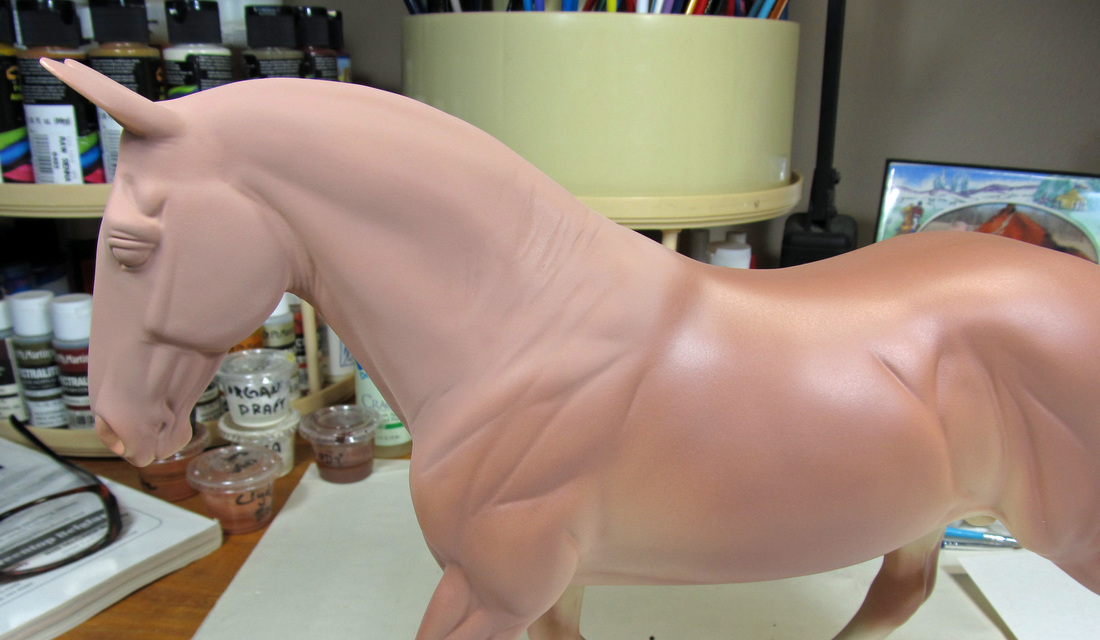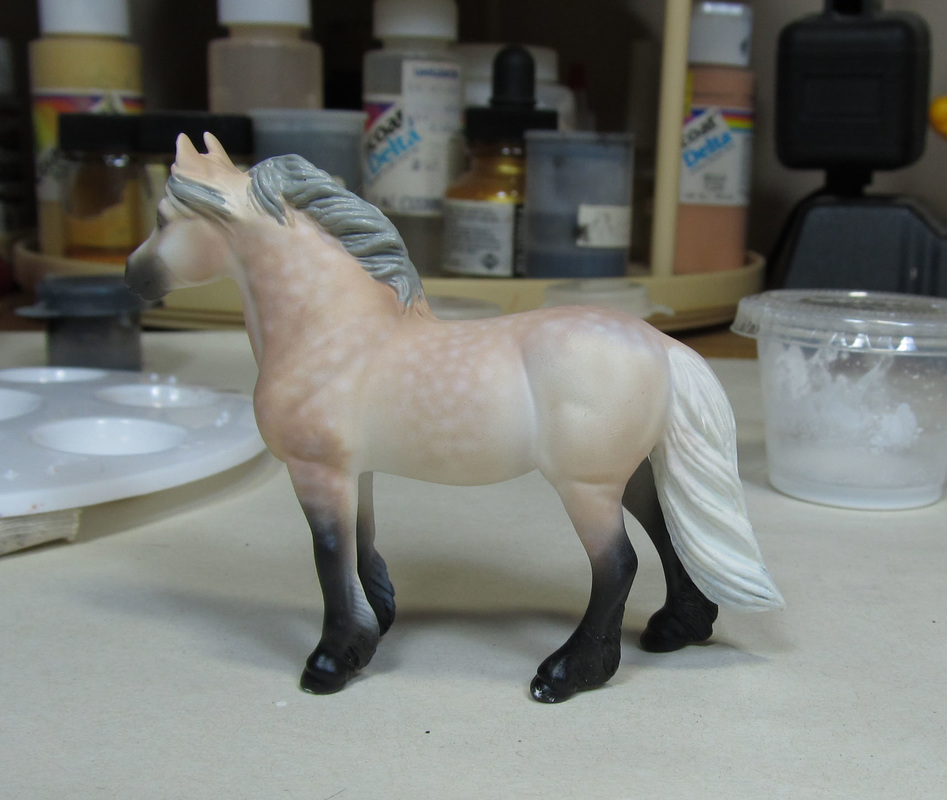Some months ago, after reading enthusiastic posts on various model horse Internet venues, raving about the wonderfulness of airbrushing Tamiya acyrlic paints, I thought I had to try these wonders for myself.
I did a bit of reading about them (they seem to be popular in other miniature hobbies) and then ordered up a bunch of colors I thought would be horse-appropriate.
Not having any bodies ready for painting, I put out a plea for prepped bodies I could try these paints out on, at a reduced cost. I painted two at that time - a chestnut and a dappled gray.
I did a bit of reading about them (they seem to be popular in other miniature hobbies) and then ordered up a bunch of colors I thought would be horse-appropriate.
Not having any bodies ready for painting, I put out a plea for prepped bodies I could try these paints out on, at a reduced cost. I painted two at that time - a chestnut and a dappled gray.
I'm now working on models 3, 4, and 5 (see photo at the top) and I thought it was time for a blog post about my experiences with Tamiya acrylic paints and my feelings and thoughts about them.
Tamiya paints put down color fast. That was the first thing I noticed about them. Even when thinned down, color build-up is very quick. Great if you are in a hurry to get a model painted.
I have mostly used "normal" acrylic paints when airbrushing models, paints that you can thin with water, like artist acrylics and airbrush paints such as Golden Fluid Acrylics, Golden High Flow, Com-Art, etc. With those, I can get lovely watercolor effects to build up color slowly, giving me rich, glowing color with soft gradients. But with the Tamiyas, the watercolor effect is much more difficult to achieve. The paints must be thinned way down and when you do that, the paint doesn't adhere well to the model - it sits on top as a layer of paint dust. Using the proprietary thinner might help, but that would be very expensive since I like to thin my paints a lot. And since the watercolor effect is little to none, I had to rethink my way of mixing colors and approach painting in a different way.
Tamiya paints, when airbrushed, go on what I call a "dusty flat". The photo below illustrates this:
Tamiya paints put down color fast. That was the first thing I noticed about them. Even when thinned down, color build-up is very quick. Great if you are in a hurry to get a model painted.
I have mostly used "normal" acrylic paints when airbrushing models, paints that you can thin with water, like artist acrylics and airbrush paints such as Golden Fluid Acrylics, Golden High Flow, Com-Art, etc. With those, I can get lovely watercolor effects to build up color slowly, giving me rich, glowing color with soft gradients. But with the Tamiyas, the watercolor effect is much more difficult to achieve. The paints must be thinned way down and when you do that, the paint doesn't adhere well to the model - it sits on top as a layer of paint dust. Using the proprietary thinner might help, but that would be very expensive since I like to thin my paints a lot. And since the watercolor effect is little to none, I had to rethink my way of mixing colors and approach painting in a different way.
Tamiya paints, when airbrushed, go on what I call a "dusty flat". The photo below illustrates this:
Believe it or not, the very flat color on head and neck is the same color that is on the rest of the body! The color on the body is what the head/neck color looks like after it has been sealed with layers of Krylon Matte Finish. So mixing colors in Tamiya acrylics is challenging to me.
Tamiya acrylics cannot be thinned with water (even though their web site states they are, "made from water-soluble acrylic resins" and they "can be washed away with plain water if done prior to curing." I've been thinning them with 91% isopropyl alcohol and I've also been using it to clean my airbrushes.
Because the paints are SO flat, sealing them with a flat sealer doesn't work (at least for me, it doesn't). I found that Krylon Matte Finish, the bane of many a model horse artist, works the best to meld all the layers and it deepens and enriches the color.
Because the paints are SO flat, sealing them with a flat sealer doesn't work (at least for me, it doesn't). I found that Krylon Matte Finish, the bane of many a model horse artist, works the best to meld all the layers and it deepens and enriches the color.
Because Tamiya paints are so coarse and opaque, I have found that they don't play nice with my better airbrushes (like my Iwata HP-C). They require an airbrush with a larger nozzle/needle combination, like the Iwata Eclipse.
Compared to the paints I am used to using, the Tamiyas go on a lot more grainy, even when thinned. Yes, regular acrylic paints and even airbrush paints can go on grainy IF you spray them without thinning them much. But if you do thin them, they can go on with little to no grain at all, especially if you use airbrush paints like Golden High Flow and Createx Wicked Detail colors. Their pigments are ground super fine for airbrushing so they go on with little to no graininess.
Since the Tamiya acrylics are geared toward military modellers, they come in a lot of military colors - Nato Brown, Hull Red, Desert Yellow. They also come in basic colors like red, green, yellow, white, and black. So with a little know-how and knowledge of color theory, you can mix yourself a whole bunch of horsey colors. But it would be nicer (and easier) if they came in "normal" artist colors like burnt umber, raw sienna and the like.
After working with the Tamiya paints for awhile now, I have to say that I still prefer my airbrush acrylics, even though it takes a heckuva lot longer to build up colors and complete a model with those. I prefer the depth of color and the soft color changes. If I need to build a solid base color up fast, then I wouldn't hesitate to use the Tamiya paints. But for the rest, I would prefer to use my airbrush paints.
One color of the Tamiya paints I really like is the white, just because it covers quickly. When I messed up the rump of a model I was painting (using my normal paints), I used the Tamiya white to quickly cover the area so I could repaint the whole section.
Compared to the paints I am used to using, the Tamiyas go on a lot more grainy, even when thinned. Yes, regular acrylic paints and even airbrush paints can go on grainy IF you spray them without thinning them much. But if you do thin them, they can go on with little to no grain at all, especially if you use airbrush paints like Golden High Flow and Createx Wicked Detail colors. Their pigments are ground super fine for airbrushing so they go on with little to no graininess.
Since the Tamiya acrylics are geared toward military modellers, they come in a lot of military colors - Nato Brown, Hull Red, Desert Yellow. They also come in basic colors like red, green, yellow, white, and black. So with a little know-how and knowledge of color theory, you can mix yourself a whole bunch of horsey colors. But it would be nicer (and easier) if they came in "normal" artist colors like burnt umber, raw sienna and the like.
After working with the Tamiya paints for awhile now, I have to say that I still prefer my airbrush acrylics, even though it takes a heckuva lot longer to build up colors and complete a model with those. I prefer the depth of color and the soft color changes. If I need to build a solid base color up fast, then I wouldn't hesitate to use the Tamiya paints. But for the rest, I would prefer to use my airbrush paints.
One color of the Tamiya paints I really like is the white, just because it covers quickly. When I messed up the rump of a model I was painting (using my normal paints), I used the Tamiya white to quickly cover the area so I could repaint the whole section.
Tamiya paints have a place in my studio, but in a supporting role. For someone wanting to put down a quick base color to put pastels or oils on top, they are great for that. But, for me, they go on too fast and too thick, not allowing for the slow build up of thin, grain-free layers. Maybe if I had started out using Tamiya acrylics at the beginning of my airbrushing endeavors, I might like them better. But I'm used to my old way of doing things and I think I will stick to the old tried and true. Sometimes newer and faster ain't better.










 RSS Feed
RSS Feed
